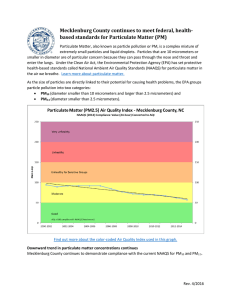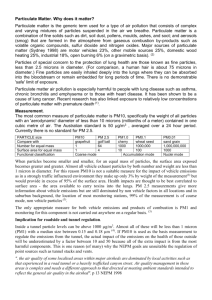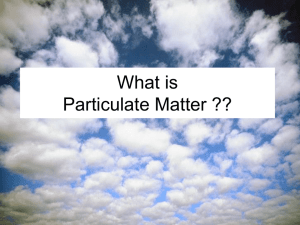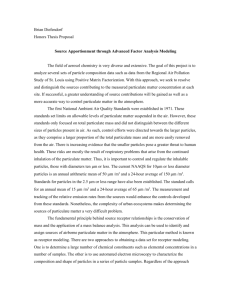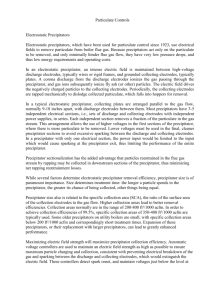Particulate Matter (PM) - EnviroTools
advertisement
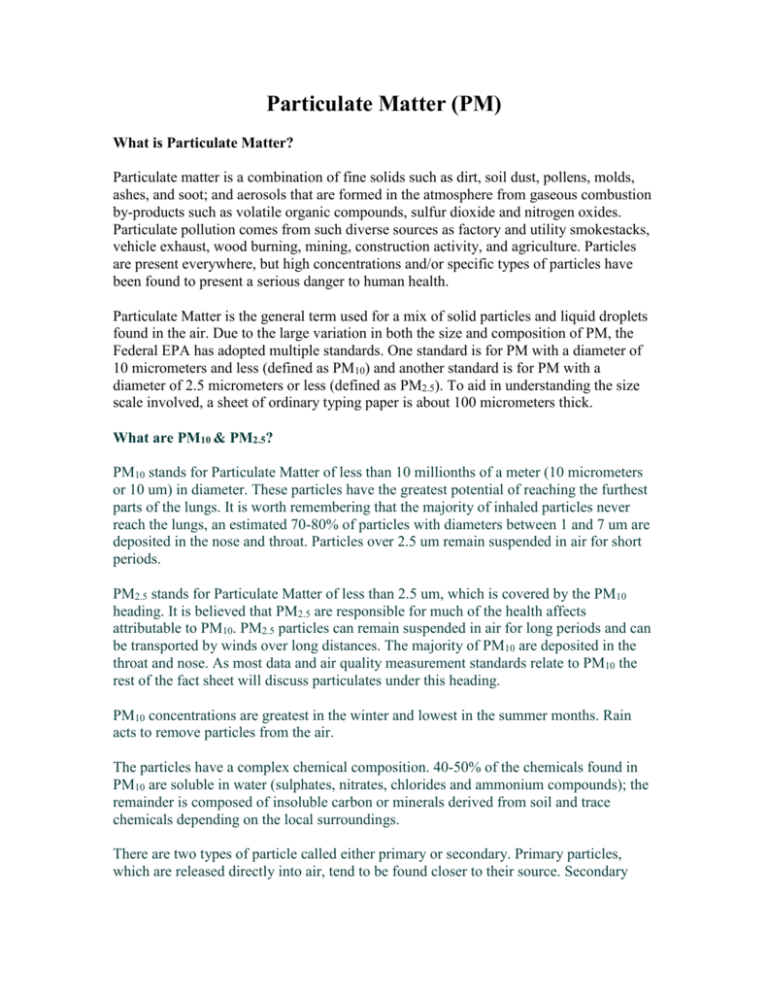
Particulate Matter (PM) What is Particulate Matter? Particulate matter is a combination of fine solids such as dirt, soil dust, pollens, molds, ashes, and soot; and aerosols that are formed in the atmosphere from gaseous combustion by-products such as volatile organic compounds, sulfur dioxide and nitrogen oxides. Particulate pollution comes from such diverse sources as factory and utility smokestacks, vehicle exhaust, wood burning, mining, construction activity, and agriculture. Particles are present everywhere, but high concentrations and/or specific types of particles have been found to present a serious danger to human health. Particulate Matter is the general term used for a mix of solid particles and liquid droplets found in the air. Due to the large variation in both the size and composition of PM, the Federal EPA has adopted multiple standards. One standard is for PM with a diameter of 10 micrometers and less (defined as PM10) and another standard is for PM with a diameter of 2.5 micrometers or less (defined as PM2.5). To aid in understanding the size scale involved, a sheet of ordinary typing paper is about 100 micrometers thick. What are PM10 & PM2.5? PM10 stands for Particulate Matter of less than 10 millionths of a meter (10 micrometers or 10 um) in diameter. These particles have the greatest potential of reaching the furthest parts of the lungs. It is worth remembering that the majority of inhaled particles never reach the lungs, an estimated 70-80% of particles with diameters between 1 and 7 um are deposited in the nose and throat. Particles over 2.5 um remain suspended in air for short periods. PM2.5 stands for Particulate Matter of less than 2.5 um, which is covered by the PM10 heading. It is believed that PM2.5 are responsible for much of the health affects attributable to PM10. PM2.5 particles can remain suspended in air for long periods and can be transported by winds over long distances. The majority of PM10 are deposited in the throat and nose. As most data and air quality measurement standards relate to PM10 the rest of the fact sheet will discuss particulates under this heading. PM10 concentrations are greatest in the winter and lowest in the summer months. Rain acts to remove particles from the air. The particles have a complex chemical composition. 40-50% of the chemicals found in PM10 are soluble in water (sulphates, nitrates, chlorides and ammonium compounds); the remainder is composed of insoluble carbon or minerals derived from soil and trace chemicals depending on the local surroundings. There are two types of particle called either primary or secondary. Primary particles, which are released directly into air, tend to be found closer to their source. Secondary particles are formed by the chemical reaction of gases in the air, these tend to be spread more evenly in rural and urban areas. What are the sources of Particulate Matter? Particulate matter comes from a number of sources. Generally, any activity which involves burning of materials or any dust generating activities are sources of PM. Along with the examples listed above, PM can come from fireplaces and cars driving on unpaved roads as well as the smoke from large industrial plants. Particles may arise from a wide variety of sources natural or man-made. Natural sources include sea spray, pollens, fungal spores or soil particles. Man-made particles mainly result from combustion processes, working with soil or rocks, industrial processes or friction of road surfaces by motor vehicles. There are six major sources of PM10: airborne road dust and soil vehicle exhausts secondary particles coal combustion incineration and the metals industry road salt and marine aerosols What are the health effects of Particulate Matter? Particulate matter is present in many different sizes. Large particles mainly come from the soil and smaller particles come from the burning of fossil fuels, like gasoline in cars and the coal used at power plants. The smaller the particle, the more dangerous, because it can travel deeper into the lungs. When particulate matter is breathed in, it can irritate and damage the lungs, causing breathing problems. People who have asthma or some type of lung or heart disease are directly impacted by high levels of PM. The elderly and children are also especially vulnerable to the effects of PM. Many studies have shown links between PM and health effects. Increases in PM have been linked to decreases in lung function, increases in breathing problems and hospitalization, and early death. Particles of special concern to the protection of lung health are those known as fine particles, less than 2.5 microns in diameter. (For comparison, a human hair is about 75 microns in diameter.) Fine particles are easily inhaled deeply into the lungs where they can be absorbed into the bloodstream or remain embedded for long periods of time. A recent study showed a 17% increase in mortality risk in areas with higher concentrations of small particles. Particulate matter air pollution is especially harmful to people with lung disease such as asthma and chronic obstructive pulmonary disease (COPD), which includes chronic bronchitis and emphysema, as well as people with heart disease. Exposure to particulate air pollution can trigger asthma attacks and cause wheezing, coughing, and respiratory irritation in individuals with sensitive airways. Recent research has also linked exposure to relatively low concentrations of particulate matter with premature death. Those at greatest risk are the elderly and those with preexisting respiratory or heart disease. What are the air quality standards for particulate matter? The federal standards for PM are: Pollutants Annual Average (Micrograms/cubic meter) 24-Hour Average (Micrograms/cubic meter) PM10 50 150 PM2.5 15 65 This fact sheet was written by Priya Heerwani, Michigan State University, TOSC Program. The information is based in part on "Small particles- Factsheet" , ncbugs.com and "Fact Sheet - Particulate Matter", the Connecticut Department of Environmental Protection (DEP).
